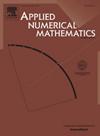三维稳态对流扩散问题的无单元混合插值Galerkin方法
IF 2.2
2区 数学
Q1 MATHEMATICS, APPLIED
引用次数: 0
摘要
研究了一种求解三维对流扩散问题的混合插值无单元伽辽金(HIEFG)方法。HIEFG方法将三维解域划分为一系列相互连接的二维子域,并在这些二维子域中采用无插值单元伽辽金(IEFG)方法形成离散方程。采用改进的插值移动最小二乘(IMLS)方法求解二维问题的IEFG方法的形状函数。采用有限差分法对二维子域上的离散方程在分裂方向上进行组合。然后,导出了三维解域中稳态对流扩散问题的HIEFG方法的计算公式。通过三个算例,讨论了影响域的节点数、分割层数和缩放参数对HIEFG技术计算精度和CPU时间的影响。该方法采用直接施加边界条件和分维技术,大大提高了计算速度。本文章由计算机程序翻译,如有差异,请以英文原文为准。
A hybrid interpolating element-free Galerkin method for 3D steady-state convection diffusion problems
This study investigates a hybrid interpolating element-free Galerkin (HIEFG) method for solving 3D convection diffusion problems. The HIEFG approach divides a 3D solution domain into a sequence of interconnected 2D sub-domains, and in these 2D sub-domains, the interpolating element-free Galerkin (IEFG) method is applied to form the discretized equations. The improved interpolating moving least-squares (IMLS) method is used to obtain the shape function of the IEFG method for 2D problems. The finite difference method is employed to combine the discretized equations in 2D sub-domains in the splitting direction. Then, the HIEFG method's formulas are derived for steady-state convection diffusion problems in 3D solution domain. Three numerical examples are used to discuss the impacts of the number of nodes, the number of split layers, and the scaling parameters of the influence domain on the computational precision and CPU time of the HIEFG technique. Imposing boundary conditions directly and the dimension splitting technique in this method significantly improves the computational speed greatly.
求助全文
通过发布文献求助,成功后即可免费获取论文全文。
去求助
来源期刊

Applied Numerical Mathematics
数学-应用数学
CiteScore
5.60
自引率
7.10%
发文量
225
审稿时长
7.2 months
期刊介绍:
The purpose of the journal is to provide a forum for the publication of high quality research and tutorial papers in computational mathematics. In addition to the traditional issues and problems in numerical analysis, the journal also publishes papers describing relevant applications in such fields as physics, fluid dynamics, engineering and other branches of applied science with a computational mathematics component. The journal strives to be flexible in the type of papers it publishes and their format. Equally desirable are:
(i) Full papers, which should be complete and relatively self-contained original contributions with an introduction that can be understood by the broad computational mathematics community. Both rigorous and heuristic styles are acceptable. Of particular interest are papers about new areas of research, in which other than strictly mathematical arguments may be important in establishing a basis for further developments.
(ii) Tutorial review papers, covering some of the important issues in Numerical Mathematics, Scientific Computing and their Applications. The journal will occasionally publish contributions which are larger than the usual format for regular papers.
(iii) Short notes, which present specific new results and techniques in a brief communication.
 求助内容:
求助内容: 应助结果提醒方式:
应助结果提醒方式:


